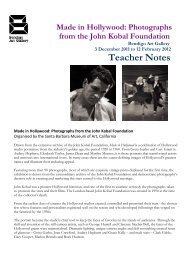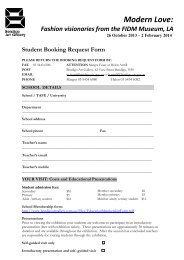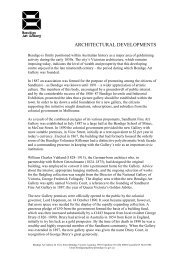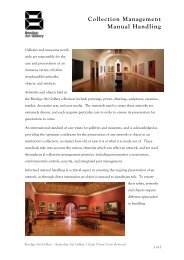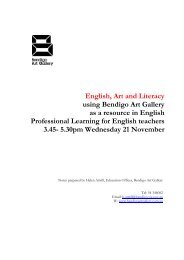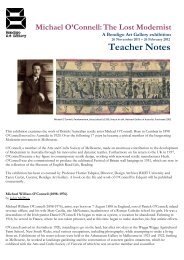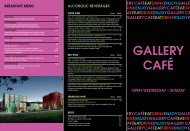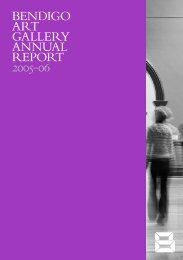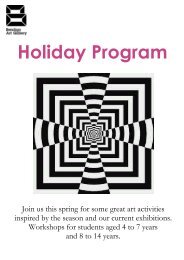Studio Arts Exam Revision booklet - Bendigo Art Gallery
Studio Arts Exam Revision booklet - Bendigo Art Gallery
Studio Arts Exam Revision booklet - Bendigo Art Gallery
You also want an ePaper? Increase the reach of your titles
YUMPU automatically turns print PDFs into web optimized ePapers that Google loves.
Conservation:<br />
Other considerations – artist’s intentions<br />
Most public galleries apply conservation in a traditional manner: The traditional definition of the role<br />
of the conservator involves the examination, conservation, and preservation of cultural heritage using<br />
"any methods that prove effective in keeping that property in as close to its original condition as possible for as long<br />
as possible”<br />
Walston, S. 1978. p.9 The Preservation and Conservation of Aboriginal and Pacific Cultural Material in Australian<br />
Museums. ICCM Bulletin Vol 4 no. 1. December 1978. Institute for the Conservation of Cultural Materials (Inc).<br />
But many contemporary artists challenge the notion of longevity or may choose materials that reflect<br />
ideas about the artwork. Other artworks may be actually constructed from new each time which may<br />
challenge the authenticity of the artwork. Galleries such as <strong>Bendigo</strong> <strong>Art</strong> <strong>Gallery</strong>, whose mission<br />
statement includes a goal to collect and promote contemporary art must strike a balance between their<br />
dual roles to both collect and protect artworks and to show current art practices. Two <strong>Bendigo</strong> <strong>Art</strong><br />
<strong>Gallery</strong> artworks that challenge the idea of longevity are: Noah Grosz’s Blockie and Kerrie Poliness’s<br />
Blue Wall Drawing.<br />
<strong>Art</strong>ist Statements:<br />
Noah GROSZ<br />
New Zealand 1970<br />
Blockie 2009<br />
natural fibres (reeds), bamboo, wood<br />
130 x 120 x 270cm<br />
Noah Grosz is a <strong>Bendigo</strong> based artist who moved to Australia from New Zealand in 1977. His early art<br />
training included life drawing with Charles Green and Lewis Miller as well as traditional oil painting<br />
techniques at CAE. He completed a Bachelor of Visual <strong><strong>Art</strong>s</strong> at La Trobe University <strong>Bendigo</strong> in 2006. His<br />
work Blockie was awarded the 2009 Dominique Segan Castlemaine Visual <strong>Art</strong>ists Biennial Award at the recent<br />
Castlemaine State Festival.<br />
<strong>Art</strong>ist’s statement:<br />
“Car culture is part of central Victorian life, and Castlemaine is known as the Street Rod centre of Australia.<br />
At surface level Blockie could be viewed purely as homage to the Street Rod fans of Castlemaine. The 1934<br />
Ford Coupe's details are slavishly researched and constructed. The name of the work, Blockie, acknowledges<br />
the practice of showing off vehicles in a continuous holding pattern around the main busiest blocks of town<br />
on a Friday or Saturday night. The sculpture is American left hand drive, something the Street Rod purists<br />
insist is the way these machines should remain as a sign of respect for the heritage of Ford.<br />
However there are other deeper levels of meaning if the viewer examines the main material used in<br />
construction. The reeds, Phragmites Australis, were sourced from gullies and creek beds that were once full of<br />
miners searching for gold, the very reason that towns such as Castlemaine and <strong>Bendigo</strong> were built in the first<br />
place. The reeds were also used by Indigenous peoples from the region in various ways. Blockie is also about<br />
questioning Colonial invasion of indigenous cultures and ensuring civilisation's effect on the natural world.”<br />
Noah Grosz, 2009<br />
12



